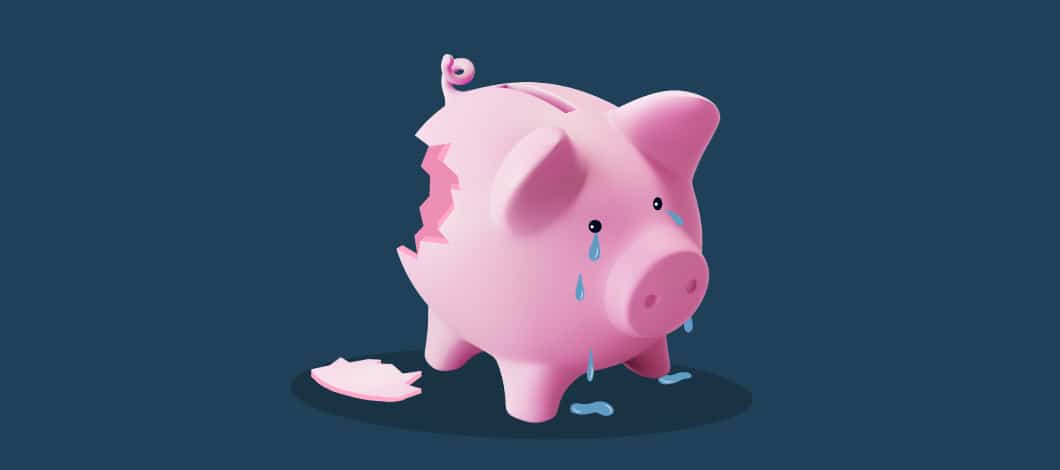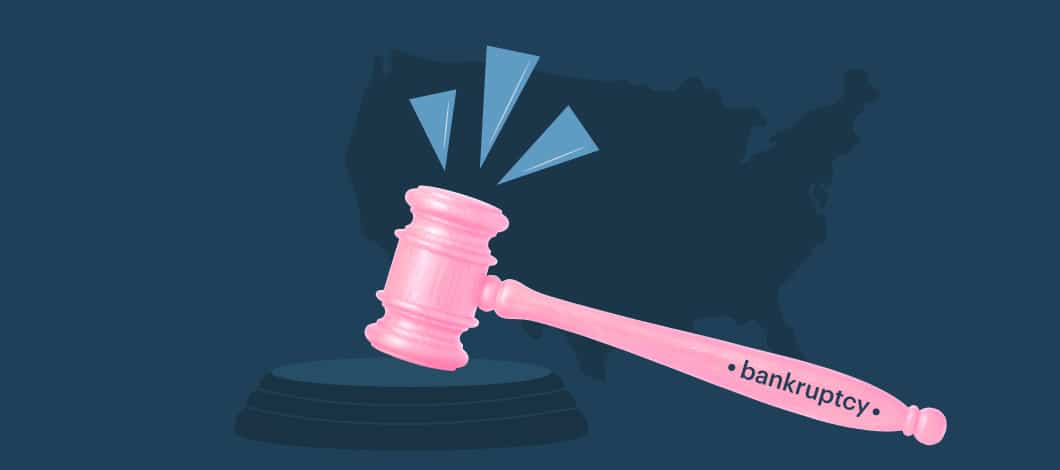Bankruptcy statistics provide insights into economic trends and the causes of business failure.
Here’s what 8 need-to-know numbers reveal.
What Is the Consumer Bankruptcy Rate?
Between Jan. 1, 2020, and Dec. 31, 2020, 496,565 consumers filed for bankruptcy protection, according to data provided by legal managed technology provider Epiq to the American Bankruptcy Institute (ABI), an organization that provides bankruptcy research and education to Congress and the public. This represented a per capita bankruptcy rate of 1.71 (filings per 1,000 people).
Bankruptcy rates were highest in the following states:
- Alabama (3.85 per 1,000 population)
- Delaware (3.62)
- Tennessee (3.39)
- Nevada (2.94)
- Mississippi (2.85)
Consumer bankruptcy filings in 2020 represented a 31% drop from 2019, which had 718,584 consumer bankruptcy filings and average national bankruptcy rates of 2.44 per 1,000 population.
The drop in filings in 2020 follows a long-term pattern in consumer bankruptcy statistics which shows a steady decline in filings over the last decade. ABI data indicates consumer bankruptcy filings had risen from 1980 to 2005, when Congress passed the Bankruptcy Abuse Prevention and Consumer Protection Act (BAPCPA).
The years immediately following saw a sharp decline in bankruptcies until the recession hit in 2007, which began to push numbers up again for several years. Consumer bankruptcy filings peaked in 2010, according to data collected by the Judiciary Data and Analysis Office (JDAO) of the Administrative Office of the U.S. Courts.
Since then, consumer bankruptcy filings have fallen each year. The amount of consumer bankruptcies in 2020 was the lowest since 1987, when there were 495,553 filings. The combined total of consumer and commercial bankruptcies fell 30% from 2019 to 2020, the second-largest percentage decrease since the passage of BAPCPA triggered a 70% drop from 2005 to 2006.

Who Files for Consumer Bankruptcy?
Consumers with low income are more likely to file for bankruptcy. The JDAO’s 2019 annual BAPCPA report showed the median average monthly income reported by all debtors filing for bankruptcy protection was $2,978 (equivalent to $35,736 a year), while median average reported monthly expenses were $2,836.
Both these figures represented a 3% increase from 2018. As this indicates, consumers are more likely to file for bankruptcy protection when they have a low-income level that is running even with their expenses, creating little opportunity to pay down debt or save.
What Causes Consumer Bankruptcy?
A survey of bankruptcy filers by a team of researchers from multiple universities identified the most frequent contributors to consumer bankruptcy as the following:
- Income loss, including medically-related work loss (61.5% of debtors strongly agreed this was a contributing factor)
- Medical expenses (37%)
- Unaffordable mortgage or foreclosure (29.2%)
- Medical problems causing work loss (27.9%)
- Divorce or separation (18.5%)
- Spending or living beyond means (17.2%)
- Student loans (14.3%)
- Changes in family size caused by events such as birth or death (13.7%)
- Trying to help friends or relatives (12.7%)
In some cases, more than one of these factors may combine to contribute to bankruptcy.
How Has the Coronavirus Affected Consumer Bankruptcy Rates?
As we mentioned, the pandemic saw a decrease of 31% in consumer bankruptcies in 2020. This result surprised experts who were expecting consumer bankruptcy filings to start rising sharply in the second quarter of last year.
Seeking to explain the counterintuitive phenomenon, a team of Harvard researchers suggested several reasons why consumer bankruptcies had gone down:
- Consumers who need to file for bankruptcy protection often can’t afford the cost of attorney fees to file bankruptcy
- Bankruptcy courts have been more difficult to access during the pandemic because of safety measures moving court proceedings online
- Federal relief measures such as the Coronavirus Aid, Relief, and Economic Security (CARES) Act have helped consumers avoid bankruptcy
- Government and corporate prohibitions on evictions and foreclosures during the pandemic have prevented bankruptcies
Another reason the pandemic didn’t cause more bankruptcies in 2020 is that economic improvements over the previous years had allowed households to reduce debt obligations. Federal Reserve data shows that, since peaking during the Great Recession in 2008, household debt-to-income ratios have fallen, meaning consumers pay less debt per month compared with what they earn. In 2020, household debt service payments as a percentage of disposable income (the ratio of debt payments to income left over after necessary expenses and taxes have been paid) fell to an all-time low going back to 1980, according to data from the Federal Reserve.
A further reason consumer bankruptcies haven’t been higher so far is that people typically spend several years trying to improve their financial situation before filing for bankruptcy protection, says law professor Pamela Foohey. She and other experts still expect to see a delayed rise in consumer bankruptcies in the aftermath of the pandemic.
What Is the Commercial Bankruptcy Rate?
2020 saw 32,506 commercial bankruptcy filings, according to the ABI. This represented a 17% drop from 2019, which saw 39,050 filings.
However, there was a rise in bankruptcy filings in the Chapter 11 category, which allows businesses to reorganize without liquidating assets in order to become financially productive again. 2020 saw 7,128 Chapter 11 commercial bankruptcy filings. This represented a 29% rise from 2019, which saw 5,519 Chapter 11 commercial filings, and the highest total since 2012, which saw 7,789 filings.
The number of Chapter 11 filings swelled partly because of filings brick-and-mortar retailers that were already struggling with ecommerce issues and debt before the pandemic, including major chains such as JCPenney, Neiman Marcus and J.Crew.
Who Files for Commercial Bankruptcy Protection?
Commercial bankruptcy is more prevalent among smaller businesses, younger firms, companies located in certain regions and businesses in certain industries.
Small Businesses Go Bankrupt More Often
Small businesses make up 99.9% of all U.S. firms, according to Census Bureau data cited by the Small Business Administration (SBA). A vast majority (86.6%) of small businesses are sole proprietorships, which are often not incorporated. This means that most small business debts are intertwined with their owners’ personal finances, making bankruptcy a way to wipe out personal debt along with business debt.
Accordingly, small businesses are statistically more likely to file for bankruptcy protection than larger firms, says bankruptcy law firm Reinherz Law Offices. About 8% of small business owners have filed for bankruptcy, according to a survey by small business insurance marketplace provider Insureon. When larger firms do file for bankruptcy protection, they are more likely than small firms to prefer reorganization over liquidation, enabling them to continue operating as they manage their debt.
Younger Companies Face Higher Bankruptcy Risks
Time in business also affects the likelihood of filing for bankruptcy protection. Businesses which have been in business a short time are more likely to go out of business because of bankruptcy or other factors than companies with a longer track record.
According to long-term data tracked by the Bureau of Labor Statistics and the Census Bureau between 1994 and 2018, business failure rates level off the longer a company has been in business. Whereas 67.6% of new businesses survive at least 2 years, only 48.8% make it 5 years, while 33.6% last 10 years and only 25.7% endure 15 years.
As this indicates, survival rates see the sharpest drop during the earliest years of a company’s existence. The longer a company has been in business, the more experience and resources it has to draw on in a financial crisis. This is one reason lenders favor companies with a longer history of operation.
Commercial Bankruptcy Rates Vary Regionally
Commercial bankruptcy rates vary by region. An analysis of JDAO data by the Kaplan Group, a commercial collection agency, found that, while populous states such as New York and California have the highest number of commercial bankruptcy filings, when population and gross domestic product are factored in, the states with the highest commercial bankruptcy risks are led by:
- Delaware
- Missouri
- New Hampshire
- Kansas
- Arkansas
- Illinois
- Pennsylvania
- Tennessee
- Mississippi
- North Carolina
Bankruptcy Rates Vary by Industry
Certain industries have had higher bankruptcy rates than others, both historically and during the pandemic. According to corporate bankruptcy data provider BankruptcyData, among large firms with more than $1 billion in assets, recent bankruptcy filings during the pandemic are led by the following industries:
- Mining, oil and gas
- Retail trade
- Transportation, communication and utilities
- Services
- Manufacturing
- Wholesale trade
- Finance, insurance and real estate
According to unemployment data published by the Bureau of Labor Statistics and analyzed by the University of New Hampshire, firms of all sizes have been hit hardest in the following industries:
- Accommodation and food services
- Local government
- Health care and social assistance
- Arts, entertainment and recreation
- Administration and support and waste services
- Manufacturing
- Other services
- Educational services
- Retail
- State government
Within the accommodation and food services sector, restaurants have been especially prone to bankruptcy. Nearly 65% of U.S. publicly-traded restaurants are at risk of bankruptcy based on their 2020 financial projections, according to an analysis of financial data by global restaurant consulting firm Aaron Allen & Associates.
Smaller restaurant chains run a higher risk of bankruptcy than larger ones, according to their analysis. Restaurants accounted for 12% of bankruptcy filings in the second quarter of 2020, outpacing all other industries. Other industries with high bankruptcy rates included healthcare, retail, telecommunications, construction, transportation and real estate.
What Causes Commercial Bankruptcy?
Insureon’s survey identified 3 top reasons small businesses file for bankruptcy protection:
- 64% file for bankruptcy protection for personal reasons
- 18% file because of a decrease in customers
- 18% file because of lawsuits
The preponderance of commercial bankruptcies filed for personal reasons reflects the frequent intertwining of personal and business finances among sole proprietorships. A review of JDAO data revealed 17% of personal bankruptcy filings involve business debt.
Additionally, small staff sizes make small businesses vulnerable to financial disruption if the owner or other key personnel encounter personal difficulties which interfere with work, such as medical problems. The average startup only employs 4.4 employees, while firms of all ages only employ an average of 22.2 employees, according to Census Bureau data.
How Has the Coronavirus Affected Commercial Bankruptcy Rates?
As with consumer bankruptcies, commercial bankruptcies during the pandemic have so far been limited because of government relief programs such as the Paycheck Protection Program, the strong economic momentum which preceded the pandemic and other factors. Overall, commercial bankruptcy filings fell 17% in 2020. However, Chapter 11 commercial bankruptcy filings which allow companies to reorganize without liquidating rose 29%, indicating that a growing number of businesses are struggling to continue operations without closing.
Apply Insights into Bankruptcy Data to Avoid Becoming a Statistic
Bankruptcy statistics can provide you with valuable insights into economic trends and the risks facing you and your business. One of the most important insights to be gained from bankruptcy data is understanding the causes of bankruptcy so that you can avoid it.
In most cases, bankruptcy reflects a disruption in cash flow stemming from a drop in personal or business income. If your business needs financing to get through a cash crunch and avoid bankruptcy, consider applying for a business line of credit or another small business financing option.











